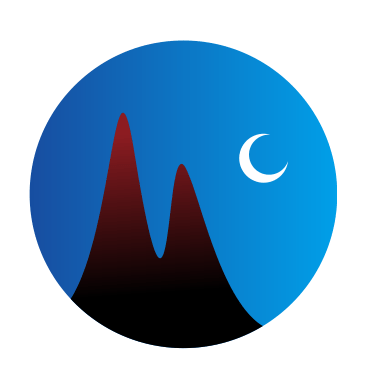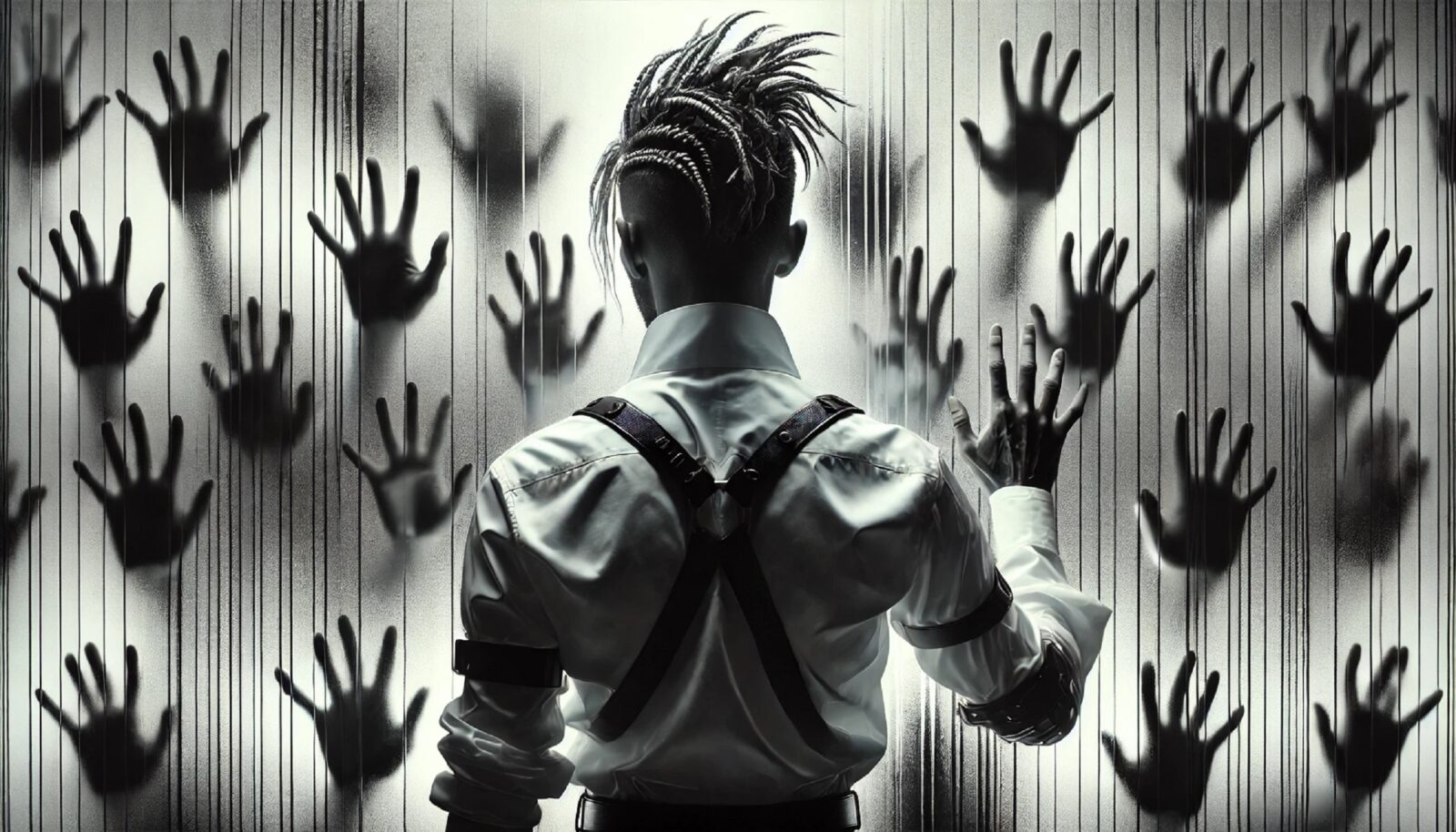Down The Rabbit Hole by Loomwave
Bottom Line Up Front: This is the complete story of how a personal diary entry from my “Dark Ages” era became “Down The Rabbit Hole,” an AI-generated hip-hop track that achieved thousands of views in days and sparked a 250% channel growth surge. The two-week creation process reveals the intricate dance between Claude AI story generation, Suno AI music production, and Luma Dream Machine animation – plus the unexpected challenge that nearly killed the project.
The Diary Genesis: Mining the Dark Ages for Musical Gold
The story of “Down The Rabbit Hole” begins not with music software or AI prompts, but with the raw material of lived experience captured in my diary. As the creator behind Diary of a Mad Chaos, I’ve documented years of personal evolution, including what I call the “Dark Ages era” – a period of intense struggle and transformation that would later become the emotional foundation for this track.
On February 24, 2025, while working on music production during a lunch break, I made a crucial creative decision. Instead of writing generic lyrics, I decided to mine my own diary entries for authentic storytelling material. This wasn’t just about finding inspiration – it was about transforming documented anxiety, personal struggles, and the experience of “taking people down the rabbit hole” with me into compelling musical narrative.
The concept resonated immediately because it wasn’t fabricated. The anxiety themes, the descent and rise patterns, the way I behave when drawing others into my chaotic thought processes – all of this existed in detailed form within my diary archives from the Dark Ages period.
Chapter 1: Claude AI Story Arc Engineering
The creation process began with a sophisticated prompt engineering session with Claude AI. Rather than asking for generic hip-hop lyrics, I requested ten different story arcs that could transform my diary experiences into musical narratives.
Claude’s response was immediate and powerful. One story arc particularly resonated: someone hitting rock bottom and choosing to rebuild rather than just recover – the courage to completely reinvent oneself rather than patch up the cracks. This wasn’t just a lyrical concept; it was my lived experience translated into narrative structure.
I then directed Claude to create a four-verse story outline focused on “descent and rise” while incorporating the specific theme of taking people into my story – essentially, down the rabbit hole with me. The AI understood the assignment perfectly, creating a framework that would translate my documented anxiety experiences into compelling hip-hop verses.
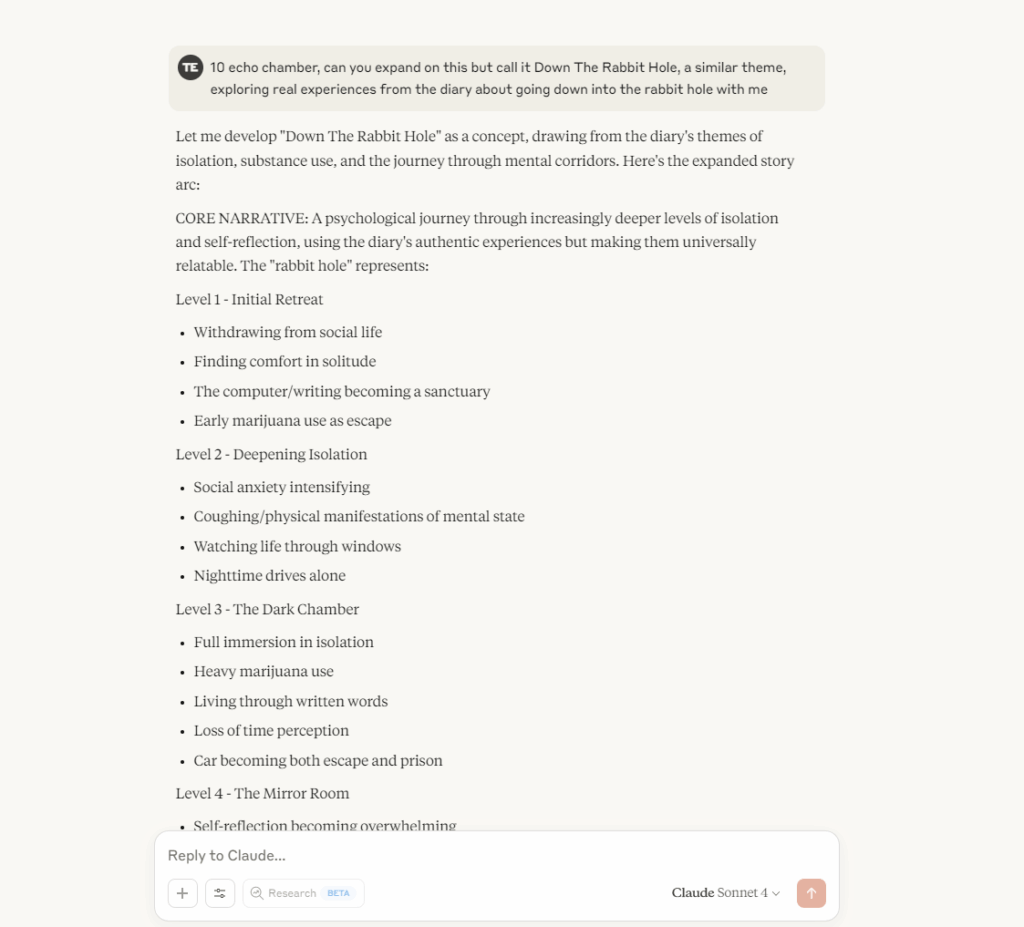
Chapter 2: Suno AI Magic and the Whisper Effect
Armed with Claude’s story outline and lyrical framework, I fed the content into Suno AI for music generation. The first result exceeded expectations in an unexpected way – instead of traditional rap delivery, Suno generated whispering vocals that created an intimate, almost confessional atmosphere.
The chorus emerged as the centerpiece: “down the rabbit hole” sung with a haunting quality that perfectly captured the psychological descent theme. This wasn’t just music; it was an audio representation of anxiety and mental spiraling that anyone who’s experienced those feelings would recognize instantly.
However, the initial version revealed structural issues. The arrangement had too many verses back-to-back without sufficient chorus breaks. I realized this would need significant reworking to achieve the proper flow for a five-minute track.
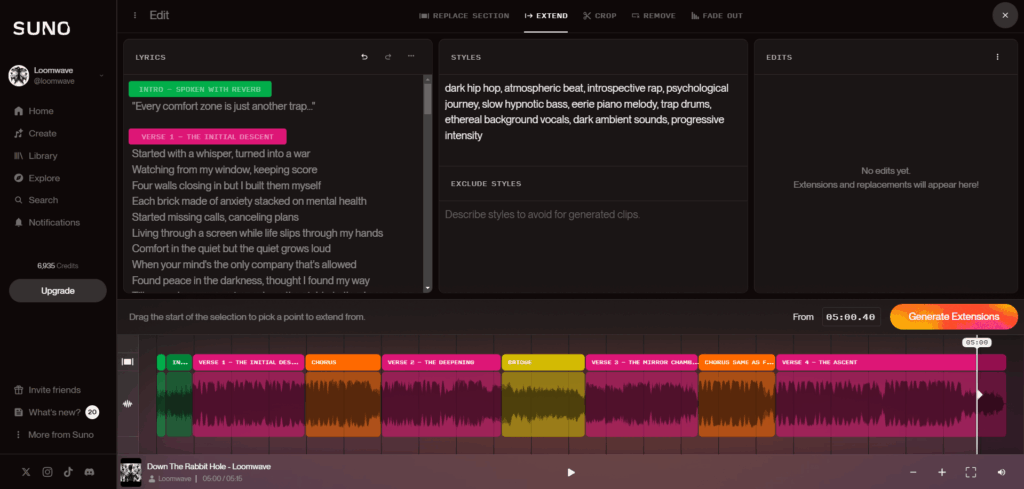
Chapter 3: The Week-Long Backlog Challenge
Here’s where the creation story gets interesting – and frustrating. While the audio was compelling, the track sat in my production backlog for over a week due to a specific technical challenge: visual content creation.
Unlike purely audio-focused musicians, my AI music production workflow requires synchronized visual elements. Each track needs:
- Album cover imagery
- Animated visual content
- Video compilation in VSDC
- YouTube-ready final product
The challenge wasn’t the music – it was finding the right visual representation for the psychological themes of “Down The Rabbit Hole.” Traditional album covers felt inadequate for a song about mental descent and anxiety spirals.
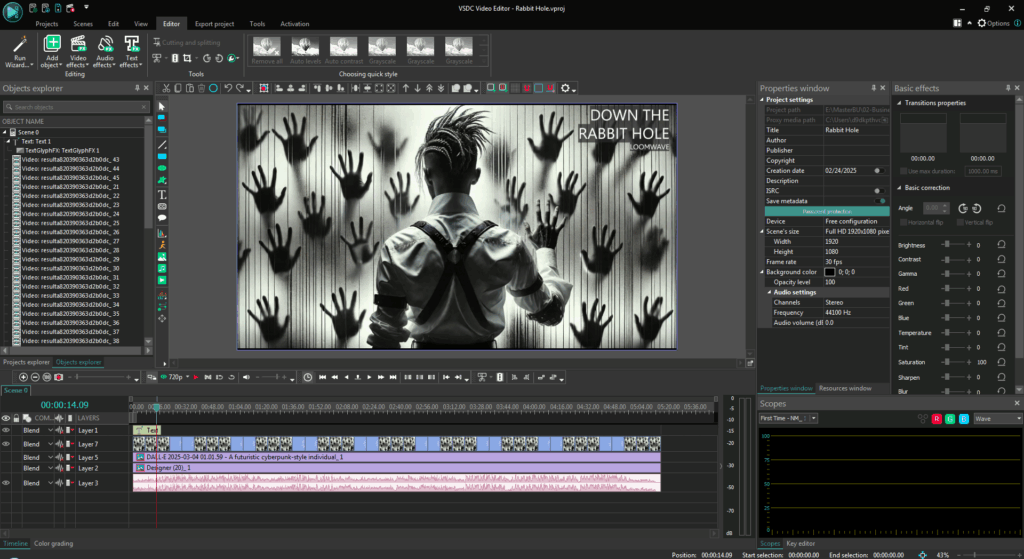
Chapter 4: The Luma Dream Machine Breakthrough
The breakthrough came when I finally had budget available for Luma Dream Machine credits. This AI animation tool became the missing piece that transformed static imagery into dynamic visual storytelling.
Working late into the night on March 3rd, I finally cracked the visual challenge. The key was creating imagery that matched the psychological mood of the track – visuals that conveyed descent, spiraling thoughts, and the disorienting experience of anxiety.
The Luma animation process brought the static cover art to life, creating movement that synchronized with the whispered vocals and hypnotic chorus. By 1:10 AM, the complete visual package was ready, and I immediately uploaded the finished track to YouTube.
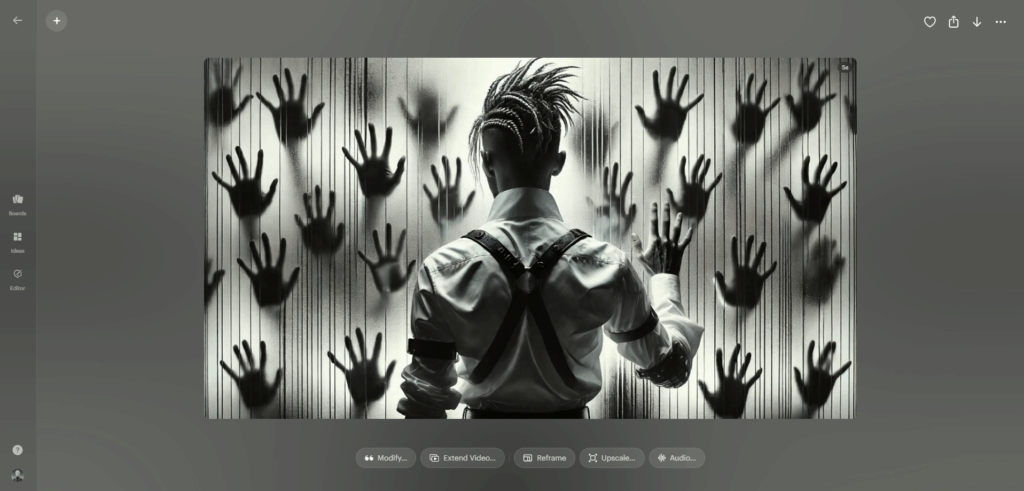
Chapter 5: Unexpected Viral Success
What happened next surprised everyone, including me. “Down The Rabbit Hole” didn’t just find an audience – it became a breakout hit with metrics that exceeded my established channel performance:
Initial Success Metrics (March 5):
- 800+ views in first 10 days
- 50+ visitors per hour sustained traffic
- 30 likes (1 like per 20 views ratio)
- Immediate subscriber growth
Peak Performance (March 13):
- 431 total channel subscribers
- 250% channel view increase
- 100 people per hour viewing the track
- Multiple replay comments from engaged listeners
The audience response revealed something important about the track’s appeal. Comments like “I replayed this over and over again. It needs captions” indicated that people were connecting with both the musical arrangement and the lyrical content on a deep level.
Chapter 6: Technical Production Workflow Revealed
For readers interested in replicating this process, here’s the complete technical workflow:
1. Diary Mining Phase:
- Review archived diary entries for emotional themes
- Identify recurring patterns and experiences
- Select era-specific content for authenticity
2. AI Story Development:
- Claude AI prompt: “Generate story arcs from [specific diary themes]”
- Request structured narrative with verse/chorus breakdown
- Refine lyrical content for musical adaptation
3. Music Generation:
- Input Claude-generated lyrics into Suno AI
- Experiment with genre specifications and vocal styles
- Generate multiple versions for arrangement comparison
4. Visual Content Creation:
- Design album cover reflecting psychological themes
- Use Luma Dream Machine for animation sequences
- Ensure visual mood matches audio atmosphere
5. Video Compilation:
- Import audio and visual elements into VSDC Video Editor
- Synchronize animation timing with musical structure
- Export YouTube-optimized final product
6. Distribution Strategy:
- Primary release on YouTube for algorithm optimization
- BandLab distribution to Spotify, Apple Music, etc.
- Social media promotion across relevant communities
Chapter 7: The Algorithm Dance and Promotion Strategy
The success wasn’t purely organic. As the initial viral momentum began declining around March 17th (from 60 to 20 views per hour), I implemented strategic promotion across Facebook groups focused on AI music and independent artists.
This reveals an important lesson about AI music production: technical excellence must be paired with marketing strategy. The best AI-generated track won’t find its audience without deliberate promotion efforts.
The promotion strategy included:
- Targeted Facebook group sharing
- Community engagement with other AI musicians
- Caption addition based on audience feedback
- Cross-platform distribution expansion
Chapter 8: Distribution Evolution and Platform Expansion
The final phase involved expanding beyond YouTube to comprehensive music distribution. Using BandLab as a distribution hub, “Down The Rabbit Hole” reached:
- Spotify
- Apple Music
- Amazon Music
- Multiple streaming platforms
This required artwork upscaling and format optimization for different platform requirements – another technical consideration often overlooked in AI music production tutorials.
Lessons Learned and Future Implications
The “Down The Rabbit Hole” creation process revealed several key insights about AI music production:
1. Authenticity Drives Engagement Using real diary entries as source material created emotional authenticity that resonated with listeners. Generic AI lyrics couldn’t have achieved the same connection.
2. Multi-Tool Mastery is Essential Success required proficiency across Claude AI, Suno AI, Luma Dream Machine, and VSDC Video Editor. No single tool could complete the vision.
3. Visual Elements Aren’t Optional The week-long delay demonstrated that modern music consumption requires synchronized visual content. Audio-only releases limit platform optimization.
4. Technical Quality Enables Viral Potential The combination of whispered vocals, haunting chorus, and psychological themes created a unique listening experience that encouraged repeat plays.
5. Community Feedback Drives Improvement Audience requests for captions led to accessibility improvements that expanded the track’s reach.
The success of “Down The Rabbit Hole” proves that AI music production, when combined with authentic personal material and comprehensive technical execution, can create content that resonates deeply with audiences. The key is treating AI tools as collaborators in storytelling rather than replacement for human experience.
For aspiring AI music producers, the lesson is clear: your personal story, properly processed through AI tools and executed with technical precision, becomes your unique competitive advantage in an increasingly crowded digital music landscape.

Diary Of A Mad Chaos is a daily diary written from March 1996 until today, of which individual books and book series have been created, namely “The Lost Years” an exploration of young, entwined love, the “Wubao In China (猎艳奇缘)” book series which provides an extensive comparative analysis of the cultural differences between Eastern and Western societies, and the book titled “Foreigner (华人)” an exploration of race relations in Australia.

